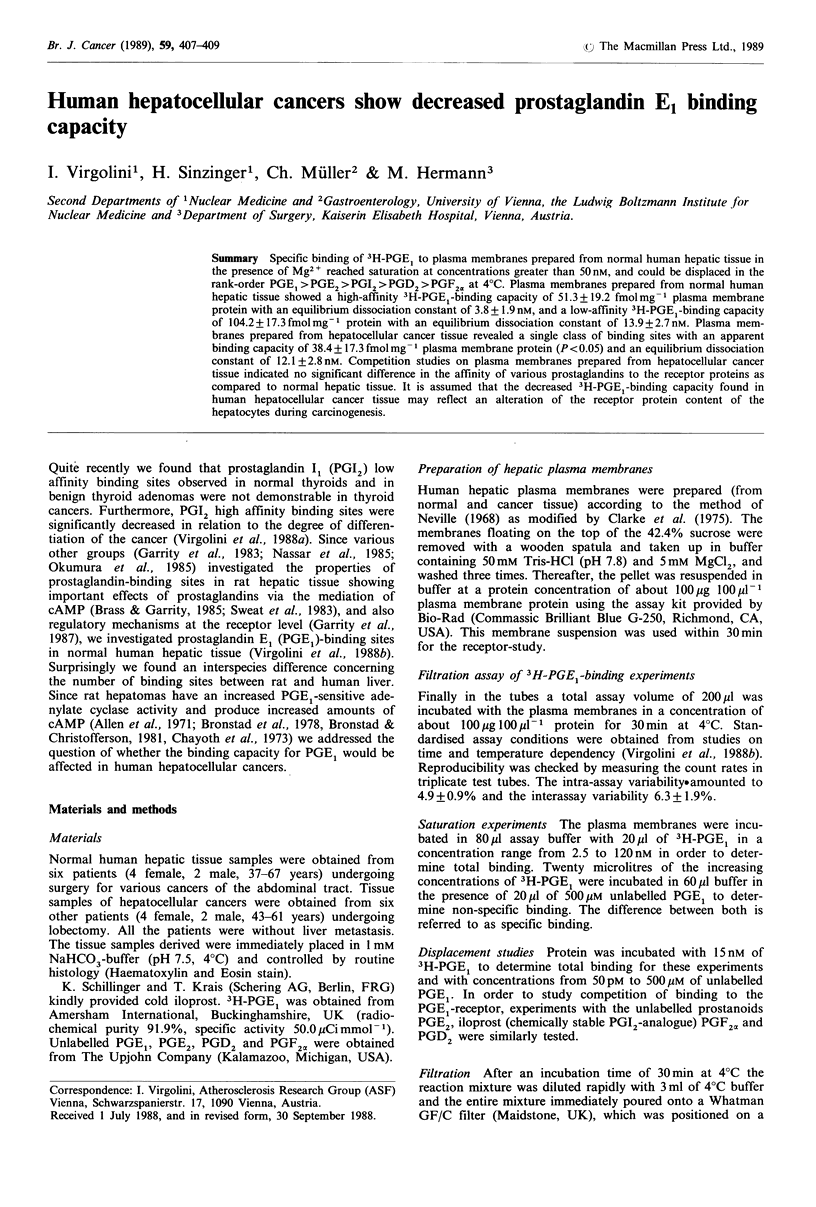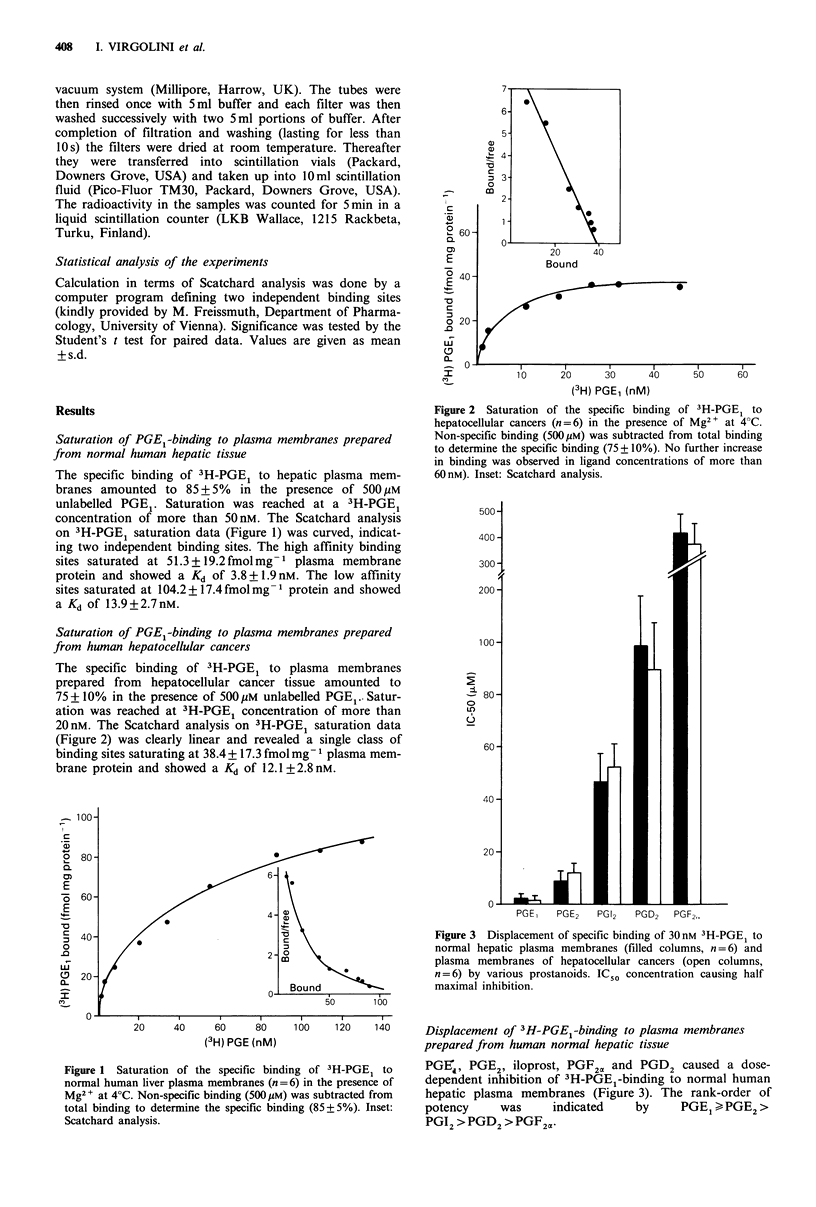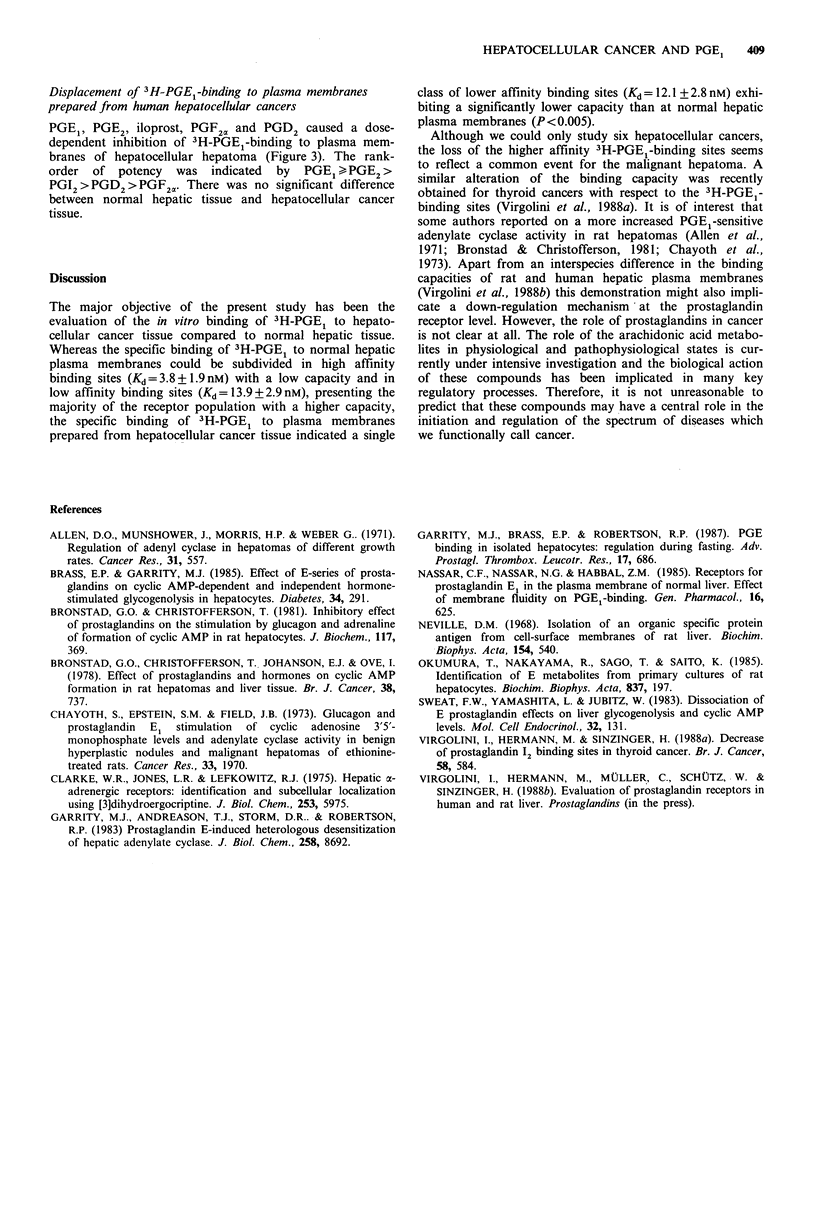Abstract
Specific binding of 3H-PGE1 to plasma membranes prepared from normal human hepatic tissue in the presence of Mg2+ reached saturation at concentrations greater than 50 nM, and could be displaced in the rank-order PGE1 greater than PGE2 greater than PGI2 greater than PGD2 greater than PGF2 alpha at 4 degrees C. Plasma membranes prepared from normal human hepatic tissue showed a high-affinity 3H-PGE1-binding capacity of 51.3 +/- 19.2 fmol mg-1 plasma membrane protein with an equilibrium dissociation constant of 3.8 +/- 1.9 nM, and a low-affinity 3H-PGE1-binding capacity of 104.2 +/- 17.3 fmol mg-1 protein with an equilibrium dissociation constant of 13.9 +/- 2.7 nM. Plasma membranes prepared from hepatocellular cancer tissue revealed a single class of binding sites with an apparent binding capacity of 38.4 +/- 17.3 fmol mg-1 plasma membrane protein (P less than 0.05) and an equilibrium dissociation constant of 12.1 +/- 2.8 nM. Competition studies on plasma membranes prepared from hepatocellular cancer tissue indicated no significant difference in the affinity of various prostaglandins to the receptor proteins as compared to normal hepatic tissue. It is assumed that the decreased 3H-PGE1-binding capacity found in human hepatocellular cancer tissue may reflect an alteration of the receptor protein content of the hepatocytes during carcinogenesis.
Full text
PDF


Selected References
These references are in PubMed. This may not be the complete list of references from this article.
- Allen D. O., Munshower J., Morris H. P., Weber G. Regulation of adenyl cyclase in hepatomas of different growth rates. Cancer Res. 1971 May;31(5):557–560. [PubMed] [Google Scholar]
- Brass E. P., Garrity M. J. Effect of E-series prostaglandins on cyclic AMP-dependent and -independent hormone-stimulated glycogenolysis in hepatocytes. Diabetes. 1985 Mar;34(3):291–294. doi: 10.2337/diab.34.3.291. [DOI] [PubMed] [Google Scholar]
- Brønstad G. O., Christoffersen T. Inhibitory effect of prostaglandins on the stimulation by glucagon and adrenaline of formation of cyclic AMP in rat hepatocytes. Eur J Biochem. 1981 Jul;117(2):369–374. doi: 10.1111/j.1432-1033.1981.tb06347.x. [DOI] [PubMed] [Google Scholar]
- Brønstad G. O., Christoffersen T., Johansen E. J., Oye I. Effect of prostaglandins and hormones on cyclic AMP formation in rat hepatomas and liver tissue. Br J Cancer. 1978 Dec;38(6):737–744. doi: 10.1038/bjc.1978.281. [DOI] [PMC free article] [PubMed] [Google Scholar]
- Chayoth R., Epstein S. M., Field J. B. Glucagon and prostaglandin E1 stimulation of cyclic adenosine 3', 5'-monophosphate levels and adenylate cyclase activity in benign hyperplastic nodules and malignant hepatomas of ethionine-treated rats. Cancer Res. 1973 Aug;33(8):1970–1974. [PubMed] [Google Scholar]
- Clarke W. R., Jones L. R., Lefkowitz R. J. Hepatic alpha-adrenergic receptors. Identification and subcellular localization using [3H]dihydroergocryptine. J Biol Chem. 1978 Sep 10;253(17):5975–5979. [PubMed] [Google Scholar]
- Garrity M. J., Andreasen T. J., Storm D. R., Robertson R. P. Prostaglandin E-induced heterologous desensitization of hepatic adenylate cyclase. Consequences on the guanyl nucleotide regulatory complex. J Biol Chem. 1983 Jul 25;258(14):8692–8697. [PubMed] [Google Scholar]
- Garrity M. J., Brass E. P., Robertson R. P. PGE binding in isolated hepatocytes: regulation during fasting. Adv Prostaglandin Thromboxane Leukot Res. 1987;17B:686–690. [PubMed] [Google Scholar]
- Nassar C. F., Nasser M. G., Habbal Z. M. Receptors of prostaglandin E1 in the plasma membrane of normal liver. Effect of membrane fluidity on PGE1 binding. Gen Pharmacol. 1985;16(6):625–627. doi: 10.1016/0306-3623(85)90155-7. [DOI] [PubMed] [Google Scholar]
- Neville D. M., Jr Isolation of an organ specific protein antigen from cell-surface membrane of rat liver. Biochim Biophys Acta. 1968 Apr 9;154(3):540–552. doi: 10.1016/0005-2795(68)90014-7. [DOI] [PubMed] [Google Scholar]
- Okumura T., Nakayama R., Sago T., Saito K. Identification of prostaglandin E metabolites from primary cultures of rat hepatocytes. Biochim Biophys Acta. 1985 Nov 14;837(2):197–207. [PubMed] [Google Scholar]
- Sweat F. W., Yamashita L., Jubiz W. Dissociation of E prostaglandin effects on liver glycogenolysis and cyclic AMP levels. Mol Cell Endocrinol. 1983 Oct;32(2-3):131–142. doi: 10.1016/0303-7207(83)90077-1. [DOI] [PubMed] [Google Scholar]
- Virgolini I., Hermann M., Sinzinger H. Decrease of prostaglandin I2 binding sites in thyroid cancer. Br J Cancer. 1988 Nov;58(5):584–588. doi: 10.1038/bjc.1988.264. [DOI] [PMC free article] [PubMed] [Google Scholar]


